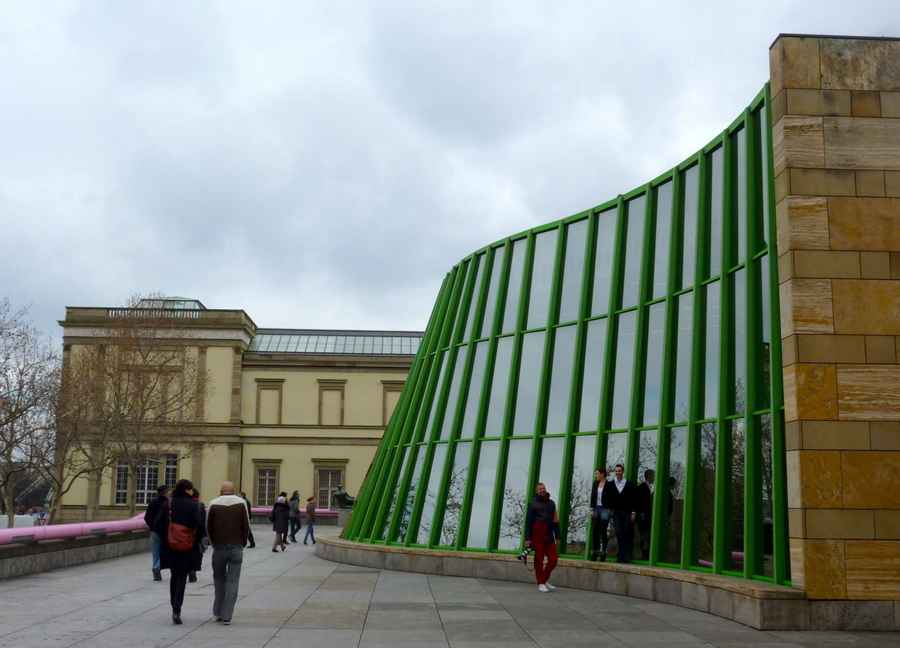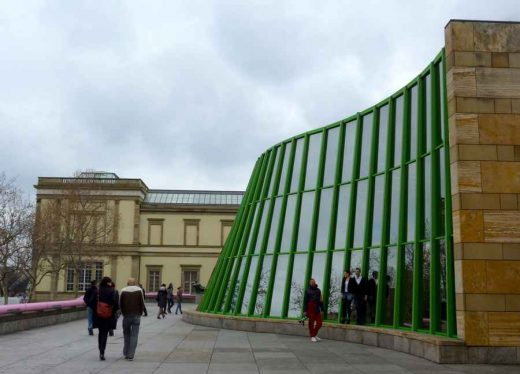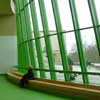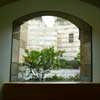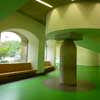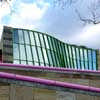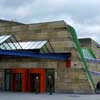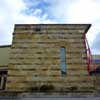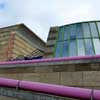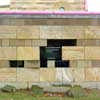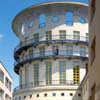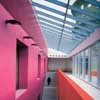Neue Staatsgalerie Stuttgart photos, German Postmodern building architect, Neoclassical Baden Wurtemburg design, Award, Date
Neue Staatsgalerie Stuttgart Building
Kulturmeile complex design by James Stirling – Architecture in Baden Wurtemburg, Germany
post updated 14 February 2024
Neue Staatsgalerie / a lesson from the past
Neue Staatsgalerie, Stuttgart, Baden-Wurttemberg
Dates built: 1977-83/84
started as Jim Stirling & Partner project completed by Jim Stirling Michael Wilford and Associates
Article by Rebecca Breun, Head of Business Development at e-architect
5 Apr 2012
Neue Staatsgalerie Stuttgart
The 1977 competition for the extension of the neoclassical Staatsgalerie and Chamber Theatre in Stuttgart, Germany, was won by British architectural firm James Stirling, Michael Wilford and Associates.
The design of the building provoked a vivid debate about postmodernism and German architecture. Postmodernism design moved away from “form follows function” and used elements from classical architecture often out of context, something made possible by new building methods and materials.
The design of the Neue Staatsgalerie has largely been credited to James Stirling (1926-92) and is considered one of his most important pieces of work.
The building opened to the public in 9th of March 1984.
Building setting
The Neue Staats galerie is situated next to the original Staatsgalerie on a slope rising up from the dual carriageway, Konrad Adenauerstrasse.
The shape of the slope is retained in the external design of the building by creating a staggered façade as oppose to the Alte Staatsgalerie which stands right up to the road, only separated from the road by a narrow pavement. More precisely, working from the front of the site towards the back, along the road is a double row of trees lining the pavement. Then a large terrace situated on top of the car park, which forms a plinth for the Neue Staatsgalerie, followed by the second terrace on the roof of the museum.
On the other side of the new Museum the Kammertheater, also design by Stirling, is pushed forward, and picks up on the assertive position of the Alte Staatsgalerie, framing the Museum. The elevation of the museum itself consists of several different elements and therefore does not appear as a conventional elevation.
The u-shape layout of the museum galleries repeats the framing exercise. From the exterior the two ends of the U-shape appear as two tall buildings at each side of the site, these structures are stone clad and appear solid, a solidity reinforced by the reduced openings and the double, oversized, concrete rainspouts at the top.
Apart from these two somewhat conventional elevations the rest of the elevation appears as an abstract reconstruction of a sloping landscape. There are three large sloping, curving windows in green, appearing as grassy banks. Then there is the ramp resembling a path working its way down a hillside.
The Museum entrance can be reached either from the Konrad Adenauerstrasse via a ramp or staircase, or by a walkway starting from Ubahnstrasse at the back of the museum. It leads you through the internal sculpture courtyard, a ruin-like rotunda with views into the lower part of the Museum. Again Stirling is digging in the dark past of architectural history, as we know it from the lay out of the English country garden and later Le Corbusier promenade architectural.
The rotunda, which is often use as the focal point of a building is just an experience on the way, the passer by cannot stay here. But the experience of the past is complete with gaping window openings, plants growing over the edge of the walls and antic statues. After this experience the passer by descends path on the facade of the Museum to arrive on the front terrace.
Here your attention is drawn to the large slanting and curving window, with view into the interior of the building and the courtyard.
However, the entrance doors are not visible they tucked away around the corner, so as not to disturb “the landscape”. The main entrance is under the blue steel and glass roof, in two orange cylinders with swing doors.
In the spacious entrance hall with its bright green floor is a gigantic interpretation of a classical temple of love, selling tickets and providing information. The hall itself has views back out over terrace toward the city and views into the rotund courtyard, creating a threshold i.e. a space which is neither outside nor inside, and both at the same time.
From the ground floor a generous ramp takes you up to the gallery level. The gallery space is divided into rectangular spaces with daylight filtering in through the roof.
It is an utterly peaceful uneventful space, no reference to the rotunda or walkways, which hands over the action to the exhibits. The gallery space is a perfect contrast to the exterior. One might even consider that the planning of the building is a collage of different architectural periods starting with the Egyptians.
Postmodern Architecture – Style Appreciation
The building is clearly a product of the early 80’s postmodern style. Some of the fenestration seems particularly flat, the colours and the over proportioned steel elements. However, if we can see beyond this the actual planning of the building is a master class in how to join classical clarity and modern usage.
It is a very fine example of postmodern architecture, in it poetic use of classical reference and use of modern materials and ways of using a building. Both the passerby and the museum visitor flow through the building using the ramps outside and inside. Before pedestrian is face with the view of Stuttgart (trees allowing) and the gentle decent on to the terrace where.
In the design process Stirling was not following the neoclassical style but rather interpreting the style and bringing it up to date by working as a “collagist”, by sticking “de Stijl canopies of steel and glass collaged onto a Schinkelesque background”. His use of colours was audacious, hot pink (oversized) handrails, bright green window structures. However, he integrated several neoclassical elements such as circular courtyard which refers to the neoclassical glass dome.
Heidegger claimed ‘the world of the work that stands there has perished. World-withdrawal and world-decay can never be undone. The works are no longer the same as they once were displaying/showing the reception/ticket area. This bright green window has now become the icon/symbol of the Neue Staatsgalerie and is the element which stats/enforces the modernity of the building, gives it its own identity and setting it apart from the Alte Staatsgalerie and surrounding buildings.
Neue Staatsgalerie Stuttgart – Article by Rebecca Breun, Head of Business Development at e-architect
Neue Staatsgalerie Stuttgart Design
History Museum, Stuttgart, Baden-Wurttemberg
2003
Design: Wilford Schupp
Adj. Music School
Music School, Stuttgart, Baden-Wurttemberg
1992-96
Design: Jim Stirling Michael Wilford and Associates then Michael Wilford and Partner
Stuttgart Music School : Stirling Prize Winner 1997
Neue Staatsgalerie, Stuttgart, Baden-Wurttemberg
Dates built: 1977-83/84
Initial design: Jim Stirling & Partner ; Later design: Jim Stirling Michael Wilford and Associates
All 3 buildings are part of the Kulturmeile complex on Konrad Adenauer Strasse
Neue Staatsgalerie Architect: James Stirling
Alte Staatsgalerie
Design: Georg Gottlob Barth
Neue Staatsgalerie Stuttgart Address: Sängerstraße 4, 70182 Stuttgart, Germany
Contact Neue Staatsgalerie, Stuttgart: 0711 47040-0
Architecture in Stuttgart
Stuttgart Architecture Designs – chronological list
Stuttgart Architecture Walking Tours
Architecture in Germany
James Stirling Exhibition, Staatsgalerie, Stuttgart, Germany
Key Late Period Building by James Stirling
Lowry Centre, Salford, England
Lowry Centre Manchester
James Stirling Architect : more details
Architecture Walking Tours by e-architect
Stuttgart Buildings
Porsche Museum
Design: Delugan Meissl
Porsche Museum Stuttgart building
Mercedes-Benz Museum
Design: UN Studio Architects
Mercedes Museum Stuttgart
Stuttgart Building – Stadium
Comments / photos for the Neue Staatsgalerie Building Website: Visit Stuttgart design by Jim Stirling & Partner / Jim Stirling Michael Wilford and Associates page welcome.

